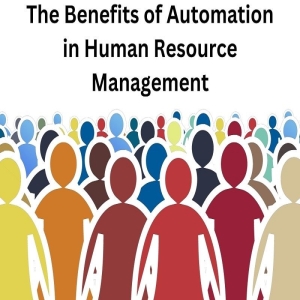The Benefits of Automation in Human Resource ManagementPosted by Bhagat singh on May 26th, 2023  IntroductionWe’ll be discussing the benefits of automation for Human Resource Management, giving you a better understanding. It can save time, money and increase productivity in your HR operations. Automation offers numerous advantages to stakeholders in terms of cost savings and accuracy. Automated systems are designed to be more efficient than manual processes which require a dedicated team of individuals monitoring and managing data input. By automating processes such as payroll, attendance tracking and even scheduling, employers can drastically reduce costs associated with cumbersome manual labor while maintaining accuracy regarding calculations. Furthermore, automated systems often provide employees with more tools at their disposal such as online timesheets or scheduling tools that allow them to manage their shifts instead of having to manually submit requests. Another benefit of automated systems is the ability they give employers to streamline processes and save time on routine tasks. By automating redundant tasks such as filling out forms or sending out notifications, HR departments can free up time for more important tasks like training and employee engagement initiatives. Automated systems also provide detailed analytics on the performance of certain tasks or employees which can help in identifying areas where further improvement is needed. Streamlining Processes and ProceduresFor businesses that are looking for ways to improve their Human Resource Management, streamlining processes and procedures is an essential component of success. By automating core processes with modern software, businesses can experience some benefits, including increased productivity, reduced costs, improved data accuracy and security, and a unified management system. Automation allows you to easily automate essential HR functions such as payroll processing and onboarding new employees. By streamlining these tasks, your organization can save time and money while also increasing productivity. Automating common processes like time tracking offers accurate and real-time data with employee hours which can be used to make informed decisions about staffing needs or provide insight into organizational trends. Streamlining also helps ensure that policies are being properly followed throughout the organization for improved compliance. You can also utilize automation to easily access records for all employees from one central location. This allows managers to review performance or shift schedules quickly which improves efficiency when making decisions regarding staffing needs or changes in roles. In addition, a unified management platform that is easily accessible from any device allows you to gain a more comprehensive understanding of your organization’s current state without having to navigate different systems separately. Finally, automation gives organizations the ability to scale as needed and adjust quickly when necessary while maintaining the accuracy and security of data at all times. With the right tools in place, businesses can remain flexible in response to changing market conditions while managing cost control measures effectively. Check out:-Technology Reviews Optimizing Hiring PracticesThe very nature of Human Resource Management (HRM) is constantly evolving due to technological advances, regulatory changes, and workforce demands. To stay ahead of the competition and remain a competitive employer for talent acquisition, organizations must optimize their HR hiring practices. Automation has become an increasingly essential tool in developing efficient and productive hiring systems. In today’s digital age, HR automation is the process of using software to automate labor-intensive or repetitive tasks related to recruitment, onboarding, and employee engagement activities. This technology offers multiple benefits that streamline the recruitment process while enhancing efficiency in organizational operations and improving accuracy in data analysis. Automated solutions can save time and money while increasing the quality of hiring decisions. HR automation can help you simplify your recruitment process by allowing you to easily post job listings on multiple job boards at once or perform advanced applicant tracking using applicant tracking systems (ATS). An ATS will give you better visibility into candidate profiles with automated search functions by keyword or other factors such as skill set experience level. This makes it easier to screen candidates quickly and accurately which reduces the time spent on manual candidate selection processes. Automated onboarding solutions offer additional benefits by reducing paperwork associated with job applications while ensuring compliance with legal requirements and industry standards for new hire processing. Employees can take care of their paperwork online through an online portal and receive feedback on their progress without delay. Automated tools also allow employees to access important documents quickly when needed which eliminates manual document searches. Check out:- In-Depth Tech Reviews Reducing PaperworkWhen it comes to managing human resources, paperwork can create a huge burden for employers and employees alike. It is time-consuming and can be extremely tedious to manage. Fortunately, automation in human resource management can reduce this paperwork burden in some beneficial ways. Automation offers a more efficient way to process HR tasks such as employee onboarding, payroll systems, and employee benefits. Automation tools allow you to streamline the entire workflow process so that you can complete manual tasks with much less effort and time. This not only saves you precious time but also reduces the possibility of errors occurring due to manual processing. Additionally, automation can be used to automate scheduling processes, such as vacation requests or shift changes. The use of automated tools also helps ensure that all requirements are met in terms of compliance with regulations and policies. Automation helps HR teams to keep up with ever-changing regulations and provides an audit trail for future reference. This makes it much simpler for employers and employees alike to stay on top of their responsibilities without having to track information or waste time on complicated paperwork processes manually. In addition to reducing the paperwork burden, automation also offers other significant benefits for HR management. For example, automated systems can make important data more accessible by providing real-time insights into employee performance and attendance records. This helps HR teams identify areas where improvements need to be made to ensure a successful workplace environment. Automation also eliminates the need for manual entry when it comes to tracking employee hours or filing timesheets — allowing companies to monitor their workforce data quickly and accurately. Check out:-Analytics Jobs Improving Communication Between HR and EmployeesFor any company to succeed, it must ensure that it has a healthy relationship between its human resources team and its employees. But in today’s fast-paced digital world, the traditional communication methods between HR and employees are becoming obsolete. Thankfully, automation through technology can help to improve communication between HR and employees to create a more efficient, effective workplace environment. The introduction of automated HR solutions into the workplace has revolutionized the way companies handle human resource tasks. Automated HR systems help streamline processes and eliminate tedious paperwork, which results in greater efficiency and improved communication between HR and employees. By replacing manual processes with automated systems, businesses can reduce the potential for human error while also increasing compliance and accuracy within their organization. As an added benefit, automated HR services also enable businesses to save money in both the short term and long term. Automation helps reduce costs associated with hiring staff such as onboarding new hires or providing training programs for existing employee development initiatives. By using automated solutions for mundane tasks, businesses can free up time for their staff to focus on more important duties related to running the business or cultivating relationships with customers or partners. Check out:-Tech Review Increasing Employee EngagementWhether it’s streamlining processes to reduce human error or introducing HRM activities to enhance employee engagement, automation has the potential to make a major impact on your workforce. Adopting automation tools can provide some advantages, from time savings and improved data accuracy and security to increased productivity and greater employee satisfaction. For your business, automating HRM activities can help you save time by allowing employees to access all the necessary information quickly and efficiently. It also eliminates the need for manual paperwork, which reduces the chances of costly errors due to human error. Automation also ensures that data remains secure and accurately recorded since information can’t be altered or corrupted as easily as it could with manual processes. Employee engagement is another important benefit of automation in HRM. Through automated tools like employee surveys or employee portals, you can gain insight into how employees feel about their roles and share more meaningful feedback with them. This encourages employees to give honest feedback so you can understand their opinions without fear of retribution or bias. This helps you create an open forum for discussion about potential issues and areas for improvement that your employees are passionate about. Additionally, automation provides an efficient way to monitor employee performance so that managers can easily see who is excelling at their job and who may need additional support or guidance for them to succeed. Enhancing Data Security MeasuresAs companies increasingly move to digital solutions for their Human Resources (HR) operations, data security measures should be a top priority. Enhancing data security by automating HR processes not only keeps sensitive information safe but can also streamline processes and help save costs. This article examines the multiple benefits of automation in Human Resource management when it comes to improved data security. First of all, automation in HR procedures eliminates the need for manual paperwork and reduces the risk of human error. Automated systems can store employee records more securely and faster than paper or other nondigital formats, thus removing the worry of lost or misplaced documents. Through automation, companies can enforce access permissions for employees at different levels of authority, ensuring more effective data management and greater transparency within an organization’s HR system. Furthermore, automated systems also provide real-time insights on payroll and personnel matters which would otherwise require extensive manual processing. By utilizing a well-designed automated system, organizations can save time on complex tasks while improving efficiency across all departments that rely upon HR information. Additionally, automated systems promise cost savings since fewer personnel are needed to manually review documents or protocols related to recruiting staff and managing payrolls. Finally, automation can help reduce the need for external services that store company information including personal data about employees or clients outside of a protected network environment. With an automated system in place, companies may be able to comply with external standards such as GDPR with fewer external resources required for compliance purposes. The Benefits of Automation in Human Resource ManagementFor employers, automated HR systems are an invaluable tool for cost savings. Automated systems can take care of mundane tasks such as payroll processing so your team can spend less time on data entry and more time on strategic initiatives. This not only reduces the burden of manual labor but also ensures accuracy in the completion of tasks. Additionally, automated systems streamline workflows so tasks are completed more quickly which translates into fewer missed deadlines or missed opportunities across all levels of the organization. At the same time, automation provides transparency and visibility into HR processes which helps promote accountability among employees while increasing efficiency in their workflows. Automated reports can provide detailed analytics on employee performance or identify areas of improvement that may have been overlooked by traditional management techniques. With access to accurate real-time data, HR managers are better equipped to strategically plan for the future of their organization or identify potential areas for growth or development within their organization’s workforce. Check out:-Ratings Like it? Share it!More by this author |


